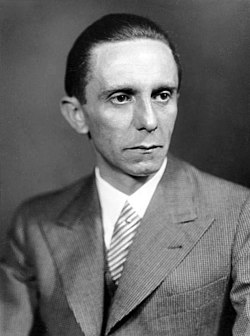
Back الدعاية النازية Arabic Нацыянал-сацыялістычная прапаганда Byelorussian Пропаганда в нацистка Германия Bulgarian Propaganda nacionalsocialista Catalan Nacistická propaganda Czech Nationalsocialistisk propaganda Danish Nationalsozialistische Propaganda German Propaganda nazi Spanish پروپاگاندا در آلمان نازی Persian Propagande nazie French

| Part of a series on |
| Nazism |
|---|
 |
Propaganda was a tool of the Nazi Party in Germany from its earliest days to the end of the regime in May 1945 at the end of World War II. As the party gained power, the scope and efficacy of its propaganda grew and permeated an increasing amount of space in Germany and, eventually, beyond.
Adolf Hitler’s Mein Kampf (1925) provided the groundwork for the party’s later methodology while the newspapers, the Völkischer Beobachter and later Der Angriff, served as the early practical foundations for later propaganda during the party’s formative years. These were later followed by many media types including books, posters, magazines, photos, art, films, and radio broadcasts which took increasingly prominent roles as the party gained more power.
These efforts promulgated Nazi ideology throughout German society. Such ideology included promotion of Nazi policies and values at home, worldview beyond their borders, antisemitism, vilification of non-German peoples and anti-Nazi organizations, eugenics and eventually total war against the Allied Nations.
After Germany’s and subsequent surrender on 7 May 1945, the Allied governments banned all forms of Nazi propaganda and the organizations which produced and disseminated such materials during the years of denazification.
© MMXXIII Rich X Search. We shall prevail. All rights reserved. Rich X Search